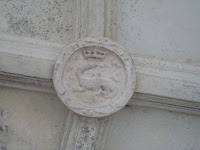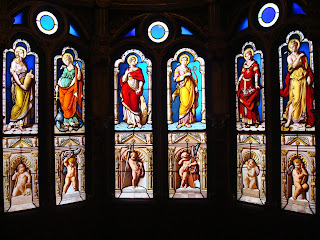The weekend at Tours started off well,
but the real excitement happened the day after. We visited the
Château du Blois. Starting as a feudal fortress around 900 C.E. The
counts of Blois rebuilt the fortress around 1200 C.E. The Chateau was
home to three kings in its days of glory ; Louis XII, François
I and Henri III. Louis XII is the guy on the horse above.
The second type of architecture is Flamboyant, pictured above. This was added by the king Louis XII during his reign there roughly 1498-1501 C.E. It is mostly constructed of brick brique and of stones pierre common to the region. This style has heavy influences from Italy.
The third style of architecture is that of the Renaissance. This large beautiful outdoor staircase was added by the King François I from 1515 to 1520 C.E. With even more influences from Italy on French architecture.
The last style is Classicisme. This was added not by a king but by Gaston d'Orléans between 1635 and 1638 C.E. He was a duke and the brother of the king Louis XIII. If you look closely at the columns the bottom starts with columns in the Doric style. The next level has Ionic columns and the third has Corinthian.
The only thing that does remain of the middle ages is the room of affairs la salle des États. But to me it was a throne room. The room was made in 1214 C.E. bu the count Thibault VI. Court was held in this room and the count or king sat in a chair much like the one I'm seated in. It wasn't very comfortable, which explains some of the French laws.
The second interesting thing is the history of everything in the castle. Like every good Château there was a chapel. Its name is la chapelle Saint- Calais after a French Hermit who made a monastery after supposedly meeting a King in the forest. It was constructed by Louis XII and consecrated in 1508. The stain glass windows this one in particular picturing Louis XII were marvelous to behold.
The Château is on a large hill, however not as large as the others I visited. On one side of the hill there is the Tour du Foix, the remains of the thirteenth century fortress used by the counts of Blois for protection. In the tower were little inlets for feudal archers to shoot medieval arrows at ancient attackers. But next to the tower was a great view of the town of Blois that sprang up around the Château. From there I could see the Eglise Saint-Nicolas. This church used to belong to a Benedictine abbey but has since broken away. The three spires were strikingly beautiful from my hilltop perspective.
Inside the Château once again I came upon the oratory of the Queen. Not only did the castle have its own little chapel but each wing had places for the royalty to pray each and every day. The stain glass window was made in the nineteenth century but it was magnificent. It is believed the Catherine de Medices had her astrologer view the stars from this oratory.
Catherine de Medicis is probably one of Frances most interesting women. Married to Henri II she was queen of France from 1547 to 1559. But Henri was, like all the other kings, more interested in his mistress Diane de Poitiers, who by the way was also the mistress of Henri's father (yuck). After Henri II died in a freak jousting accident, which by the Nostradamus told the queen (yeah he was her personal psychic for a while) that Henri would have an accident if he jousted, her 15 year old son François II became king. She immediately kicked Diane to the curb and took power that the king had refused to give her. But she still had oposition. The wife, Mary Stuart (who would later become Mary Queen of Scots) was being used by another French family (the Guise family) to try and control the throne. More political power was given to Catherine when François died of what is believed to have been an ear infection. Catherine expelled Mary to Scotland, and Mary didn't have such a very good time there (For things I'm not sure she did, she was excuted). Cahterine then became regent to her next son, Charles IX who was very young. Unfortunately for Catherine the wars of Religion were happening in France. After a Huguenot leader was attacked Charles told his men to kill all the protestants, which probably wasn't the greatest of ideas. This led to the St. Bartholomew's Day massacre that saw the deaths of thousands of Protestants. (estimations between 5,000 and 30,000 no one is better at killing the French than the French). After that Charles died too and Catherine saw her third and probably smartest son become king Henri III. Unlike her other sons he was grown and in good health and smarter. She constantly prayed for her children and for her dead husband and died of a lung infection.
While I was in the castle I saw some bizarre things. A gargoyle who looked absolutely terrified and a monkey on a ball and chain. Who knew the French had monkeys?
The third interesting thing is the emblems of the royal houses. The Porcupine above is the emblem of the House of Orléans. The porcupine with a crown is the Emblem of Louis XII, the Father of the People. He was extremely benevolent with his domestic policies.




The next emblem is the emblem of François I. He was known as the Knight King for his constant appearances on the battle field he conquered Milan in Italy and brought a lot of Italian influence back with him from there. I'll probably go into more detail about him in another post.
The Last emblem is that of Henri II, the husband of Catherine de Medici and the father of the three following Kings. Henri was the son of François I. But the apple was thrown far from the tree.
Eyewitness Travel, Wikipeidea Guide of Blois

























No comments:
Post a Comment